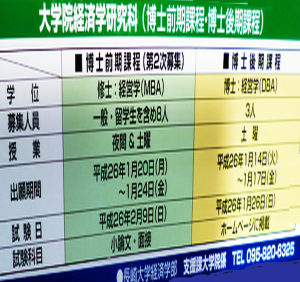University Gates with Job Ads Instead of Ivy

That seemed unusual, and triggered the question of whether, in general, disclosing in advance exactly how many people will be hired for a given job is a very good, bad or indifferent idea—in addition to the question of the wisdom of advertising on your office building or campus wall.
Because all of my travels in the past decade have been outside North America, I don’t know whether Harvard or the University of Wyoming are using their street frontage or their buildings to hang “help wanted” signs or with such detail. But, I’ve never seen anything like that anywhere than here.
Setting aside the question of uniqueness, the other features just broached warrant close consideration, irrespective of how common posting such signs is in any locale.
A Harvard Job Billboard? The Pros and Cons
Contextualizing the practice, imagine such a sign on a Harvard gate:
“Now recruiting: The venerable Graduate Department of Economics, Harvard University—General Administration (4 data entry positions); Accounting (3 junior accountants); Student Affairs (2 liaison officers). Apply with full resume by July 23, 2014. Minimum requirements: previous experience, technical or undergraduate diploma/degree, references. Contact: Harvard University Staff Management Office: 555-555-5555 or email: hrvrdjobs@ivylg.edu.”
So, what’s wrong with this, if anything? Alternatively, what’s great about it?
—That kind of ad may come across as tacky to those who don’t like being reminded that universities and colleges are, in fact, businesses—regardless of whether they are public or private. Somehow, the lofty ivory towers of academe are, in their eyes, expected to soar high above the profane concerns of turning a profit or at least breaking even.
This risk of disdain can be generalized to any organizations, especially NGOs, that need to be or are generally perceived as “pure”, altruistic and not a business, despite the obvious, commonsensical logistical requirements for staff in any organization, the extreme case being a Buddhist temple advertising for accountants and lawyers.
But to others—especially John Galt/Ayn Rand “Atlas Shrugged” laissez-faire capitalist entrepreneurial types, that disdain for the ad is at best snobbery and at worst collectivist, socialist ideological rubbish, and dangerous rubbish, at that, given its implied contempt for the profit motive and entrepreneurial drive.
—An ad like that, whether for a university or for any other business, can subliminally send a wrong message: that our organization actually has to ask people to apply for jobs with us. This can adversely impact brand and image.
For example, I was unable to get my job at Ocean University of China teaching graduate courses in things like philosophy of language and scientific method) through the recruiter who got me my previous job in Chengde.
She told me that the university is so prestigious that they never use recruiters—implying that OUC neither wants nor needs to do so.
Ironically, I got the job by just dropping by (resume and other resources in hand) while scouting and having an in-depth chat with the chairman, who happened to be in his office on what was a national holiday. (Fortuitously, the department wanted someone—you guessed it—with a philosophy of science, critical thinking and ESL-teaching background.)
—Listing the required staff numbers can make the job-seeking brain pause and start wondering: If the numbers are quite small, say just 1, that may discourage some qualified, yet diffident applicants who fear competition.
Of course, it is normal to assume that an advertised job opening is likely to require only one hire; but, somehow, when that it made explicit, it can trigger anxieties, much as looking at a life expectancy table does, even though it only confirms what we pretty much already know.
On the other hand, if the numbers of staff to be hired are substantial, those ultimately rejected may feel even worse knowing that they didn’t make the cut, despite the large number of openings, and feel more resentment or confusion than normal.
Again, this is what might be called, for want of a term, an “explicitness effect”: making something almost obvious explicit creates problems, much as being told that your tie that you know or suspect is hideous makes it and your feelings about it a problem.
—Publicly posting numbers of staff to be hired and the qualifications, experience, etc., required can make current staff anxious and suspicious, or at least make them vigilant enough to try to confirm that the ads represent planned expansion, rather than as yet unannounced dismissals or reassignment of themselves.
In countries in which “saving face” is of particular importance, this kind of uncertainty or ambiguity may be perceived as reflecting badly on the existing staff, to the extent that there may be some implication that their jobs are on the line.
—On the plus side, at least the public ads suggest that the organization is not going under and that there is some “energy” in it, especially when the required staff numbers are large.
The physical proximity to the HR department also streamlines and shortens the process, while promoting in-person first-contact, e.g., for organizational prospectus or job information.
Noting the appearance and manner of potential applicants who show up spontaneously can provide useful supplemental information about and impressions of them, in advance of the full-formal application and interview. All that is required is a mental memo about the first encounter at the counter.
Although the billboard ad does not have the flexibility of an online job-board posting, that too can be achieved through some basic technology: Just replace the painted or printed sign with a digital one, with information that can be instantly changed as required.
That flexibility is so complete that it can well serve both organizations that are having recruitment, turnover and retention problems and those that are enjoying spectacular growth.
There is, it is worth noting, one special billboard format that can meet the needs of both of these extremes, get the message across and out there. and ensure phenomenal success: a streaming digital ticker-tape…
…with a digital Harvard logo.

